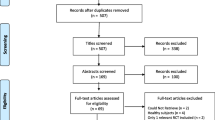Abstract
This chapter describes the various effects of Kinesio Taping and how it can be used as a modality for pain reduction, with the most popular theory being that Kinesio Tape lifts skin and allows movement of interstitial fluid. The techniques described and shown in this chapter are in relation to the back, shoulder, and knee. Multiple articles were reviewed and discussed. It is the authors’ beliefs that Kinesio Taping can provide biomechanical feedback, close dead space, provide mechanical correction, and should be used in conjunction with other pain management strategies.
Access this chapter
Tax calculation will be finalised at checkout
Purchases are for personal use only
Similar content being viewed by others
References
Turk DC, Theodore BR. Epidemiology and economics of chronic and recurrent pain. In: Clinical pain management: a practical guide. New York: Wiley; 2010. p. 6–13. https://doi.org/10.1002/9781444329711.ch2.
Bandyopadhyay A, Mahapatra D. Taping in sports: a brief update. J Hum Sport Exerc. 2012;7(2):544–52. https://doi.org/10.4100/jhse.2012.72.17.
Bassett KT, Lingman SA, Ellis RF. The use and treatment efficacy of kinaesthetic taping for musculoskeletal conditions: a systematic review. NZ J Physiother. 2010;38(2):56–63.
Kelle B, Güzel R, Sakallı H. The effect of Kinesio taping application for acute non-specific low back pain: a randomized controlled clinical trial. Clin Rehabil. 2016;30(10):997–1003. https://doi.org/10.1177/0269215515603218.
Kinesio Taping Association International. KT1: fundamental concepts of the Kinesio Taping® Method and KT2: advanced concepts and corrective techniques of the Kinesio Taping® Method. Albuquerque: Kinesio Taping Association International; 2013.
Kul A, Ugur M. Comparison of the efficacy of conventional physical therapy modalities and kinesio taping treatments in shoulder impingement syndrome. Eurasian J Med. 2019;51(2):138–43. https://doi.org/10.5152/eurasianjmed.2018.17421.
Li Y, Yin Y, Jia G, Chen H, Yu L, Wu D. Effects of kinesiotape on pain and disability in individuals with chronic low back pain: a systematic review and meta-analysis of randomized controlled trials. Clin Rehabil. 2018;33(4):596–606. https://doi.org/10.1177/0269215518817804.
Logan CA, Bhashyam AR, Tisosky AJ, Haber DB, Provencher MT. Systematic review of the effect of taping techniques on patellofemoral pain syndrome. Sports Health. 2017;9(5):456–61. https://doi.org/10.1177/1941738117710938.
Morris D, Jones D, Ryan H, Ryan CG. The clinical effects of Kinesio® Tex taping: a systematic review. Physiother Theory Pract. 2012;29(4):259–70. https://doi.org/10.3109/09593985.2012.731675.
Nelson NL. Kinesio taping for chronic low back pain: a systematic review. J Bodyw Mov Ther. 2016;20(3):672–81. https://doi.org/10.1016/j.jbmt.2016.04.018.
Thelen M, Dauber J, Stoneman P. Clinical efficacy of kinesio tape for shoulder pain: a randomized, double-blinded, clinical trial. J Orthop Sports Phys Ther. 2008;38:389–95.
Further Reading
Araya-Quintanilla F, Gutiérrez-Espinoza H, Sepúlveda-Loyola W, Probst V, Ramírez-Vélez R, Álvarez-Bueno C. Effectiveness of kinesiotaping in patients with subacromial impingement syndrome: a systematic review with meta-analysis. Scand J Med Sci Sports. 2022;32(2):273–89. https://doi.org/10.1111/sms.14084.
Author information
Authors and Affiliations
Corresponding author
Editor information
Editors and Affiliations
Rights and permissions
Copyright information
© 2022 The Author(s), under exclusive license to Springer Nature Switzerland AG
About this chapter
Cite this chapter
Noble, M.B., Noble, S.K., Shively, S.R., Jackson, S.B. (2022). Kinesio Taping for Bedside Pain Management. In: Souza, D., Kohan, L.R. (eds) Bedside Pain Management Interventions. Springer, Cham. https://doi.org/10.1007/978-3-031-11188-4_17
Download citation
DOI: https://doi.org/10.1007/978-3-031-11188-4_17
Published:
Publisher Name: Springer, Cham
Print ISBN: 978-3-031-11187-7
Online ISBN: 978-3-031-11188-4
eBook Packages: MedicineMedicine (R0)




